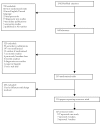Design, analysis, and presentation of crossover trials
- PMID: 19405975
- PMCID: PMC2683810
- DOI: 10.1186/1745-6215-10-27
Design, analysis, and presentation of crossover trials
Abstract
Objective: Although crossover trials enjoy wide use, standards for analysis and reporting have not been established. We reviewed methodological aspects and quality of reporting in a representative sample of published crossover trials.
Methods: We searched MEDLINE for December 2000 and identified all randomized crossover trials. We abstracted data independently, in duplicate, on 14 design criteria, 13 analysis criteria, and 14 criteria assessing the data presentation.
Results: We identified 526 randomized controlled trials, of which 116 were crossover trials. Trials were drug efficacy (48%), pharmacokinetic (28%), and nonpharmacologic (30%). The median sample size was 15 (interquartile range 8-38). Most (72%) trials used 2 treatments and had 2 periods (64%). Few trials reported allocation concealment (17%) or sequence generation (7%). Only 20% of trials reported a sample size calculation and only 31% of these considered pairing of data in the calculation. Carry-over issues were addressed in 29% of trial's methods. Most trials reported and defended a washout period (70%). Almost all trials (93%) tested for treatment effects using paired data and also presented details on by-group results (95%). Only 29% presented CIs or SE so that data could be entered into a meta-analysis.
Conclusion: Reports of crossover trials frequently omit important methodological issues in design, analysis, and presentation. Guidelines for the conduct and reporting of crossover trials might improve the conduct and reporting of studies using this important trial design.
References
Publication types
MeSH terms
LinkOut - more resources
Full Text Sources
Medical
Molecular Biology Databases


